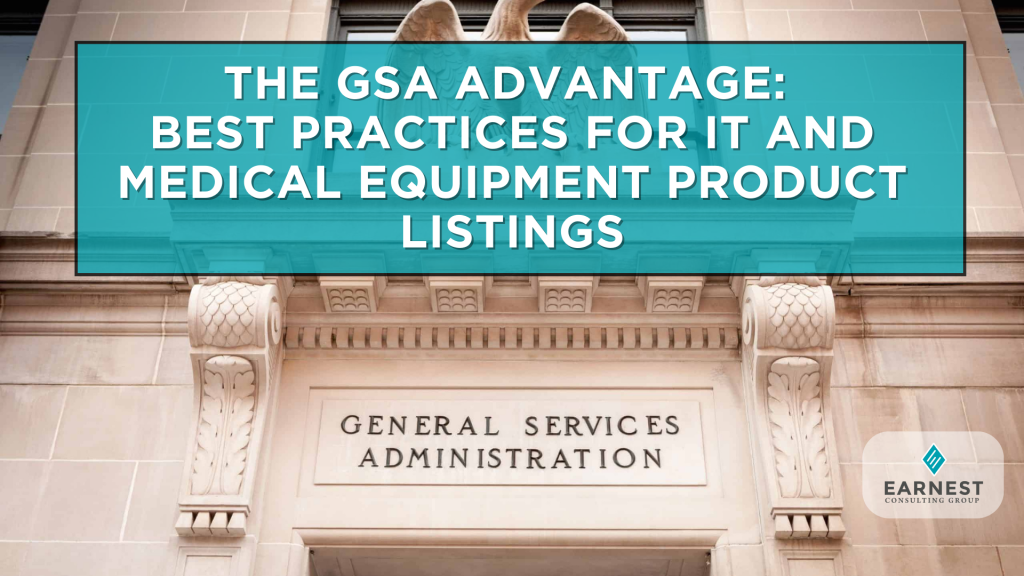The GSA Advantage: Best Practices for IT and Medical Equipment Product Listings
April 10, 2025 | Government
If you sell IT products or medical equipment and have a GSA Schedule—or are thinking about getting one—this is for you. In this week’s article, we break down the best practices that actually move the needle on GSA. Because listing your products isn’t the same as selling them. And nothing drives sales faster than getting away from your computer and picking up the phone.
If there’s one thing I hear all the time from product companies trying to break into the federal market, it’s this: “If we just had a GSA Schedule, we’d start winning contracts.”
The data—and experience—say otherwise.
Thousands of companies hold a GSA Schedule and never win a single dollar in sales. Why? Because the GSA Schedule is a car, but if you don’t give it any gas, it won’t move. And just like any car, it only works if you know how to use it. So if you sell IT products or medical equipment, this article is for you. We’re breaking down the best practices for getting found, getting chosen, and getting paid through your GSA Advantage listings.
1. Do the Homework Before You List
Before you start uploading SKUs and pricing files, take a step back. Ask: Who’s buying what I sell??
Not all agencies or buyers use GSA right now for every purchase, but in light of Executive Order 14099, Eliminating Waste and Saving Taxpayer Dollars by Consolidating Procurement, you may want to widen your outreach to everyone who buys what you sell. Use tools like FPDS, SAM.gov, and USAspending.gov to answer these questions:
- What agencies are buying your product category (based on PSCs and keywords)?
- When are they most actively buying it?
- What vendors are currently winning those awards?
This research ensures your GSA listing is a strategic move—not just a checkbox.
2. Nail the GSA Advantage Listing Basics
Your product listing is your storefront. And if your storefront is a mess, you’re not going to get much foot traffic.
Here are some quick Dos and Don’ts:
Do:
- Use specific, searchable product names and descriptions.
- Include relevant keywords your buyers might use.
- Highlight compliance features like TAA or FDA registration.
- Call out if the item is made in the USA.
- Price competitively, with an eye on your margins (and micro-purchase implications).
Don’t:
- Upload a bloated catalog without a strategy
- Assume buyers will “find you” just because you’re listed
- Let listings go stale—keep pricing and descriptions current
- Ignore the Brand Name or Equal clause—be clear and confident when offering an equal
3. Don’t Wait—Proactively Sell What’s on GSA
You can’t just list your products and expect orders to show up. The companies winning consistently are proactively selling through the GSA channel.
That means:
- Running contract award reports to see who buys what you sell
- Following up with buyers who’ve made open-market purchases to explore a move to GSA
- Mentioning your GSA Schedule number in every outreach and quote
- Watching for RFQs on GSA eBuy and submitting quotes quickly and confidently
Buyers value ease of purchase. If your products are priced right, easy to find, and easy to order—GSA becomes a real advantage.
4. Use Brand Name or Equal to Your Advantage
Brand name or equal solicitations can be huge opportunities. Don’t be discouraged if the RFQ lists a brand name and you’re offering something different. If your product meets or exceeds the salient characteristics, you should bid.
Just make sure:
- You clearly explain how your product meets the listed characteristics
- You attach supporting documentation from your manufacturer
- You never misrepresent country of origin
Even if they pick the brand-name option this time, they’ll remember you for future needs—especially if your documentation was clear and professional.
5. Build Relationships by Picking Up the Phone
Your GSA listing doesn’t drive sales. You do. And the best sales tool you have is your phone.
Upstream, that means calling your suppliers and manufacturers to tighten pricing and get faster support. Downstream, it means making calls to real buyers—not sending blind emails, not waiting on bid alerts, but actually dialing the people who buy what you sell.
Here’s what effective product sellers are doing right now:
- Calling contracting officers to ask if a recent purchase could be moved to GSA for ease of procurement
- Checking in with previous buyers to share updated GSA pricing or new product lines
- Reaching out to end users—clinical staff, IT managers, facility directors—who influence purchases and need to know you exist
Most of your competitors won’t make these calls. That’s your advantage. Your listing may be online, but your success starts on the phone.
Bottom line? GSA isn’t a waiting game—it’s a phone game. And the ones making the calls are the ones getting the orders.
If you like what you see in this article and are ready to get to work on increasing your product sales margins, click here to schedule a call with me. Let’s put together a plan that works.
« Back to Blog Home




